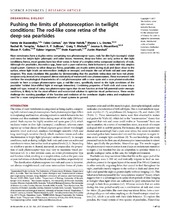| dc.contributor.author | Busserolles de, Fanny | |
| dc.contributor.author | Cortesi, Fabio | |
| dc.contributor.author | Helvik, Jon Vidar | |
| dc.contributor.author | Davies, Wayne I. L. | |
| dc.contributor.author | Templin, Rachel M. | |
| dc.contributor.author | Sullivan, Robert K. P. | |
| dc.contributor.author | Michell, Craig T. | |
| dc.contributor.author | Mountford, Jessica K. | |
| dc.contributor.author | Collin, Shaun P. | |
| dc.contributor.author | Irigoien, Xabier | |
| dc.contributor.author | Kaartvedt, Stein | |
| dc.contributor.author | Marshall, Justin | |
| dc.date.accessioned | 2018-03-02T12:49:00Z | |
| dc.date.available | 2018-03-02T12:49:00Z | |
| dc.date.issued | 2017 | |
| dc.Published | Busserolles de, Cortesi F, Helvik JV, Davies, Templin, Sullivan, Michell, Mountford, Collin SP, Irigoien X, Kaartvedt S, Marshall J. Pushing the limits of photoreception in twilight conditions: The rod-like cone retina of the deep-sea pearlsides. Science Advances. 2017;3:eaao4709 | eng |
| dc.identifier.issn | 2375-2548 | en_US |
| dc.identifier.uri | https://hdl.handle.net/1956/17487 | |
| dc.description.abstract | Most vertebrates have a duplex retina comprising two photoreceptor types, rods for dim-light (scotopic) vision and cones for bright-light (photopic) and color vision. However, deep-sea fishes are only active in dim-light conditions; hence, most species have lost their cones in favor of a simplex retina composed exclusively of rods. Although the pearlsides, Maurolicus spp., have such a pure rod retina, their behavior is at odds with this simplex visual system. Contrary to other deep-sea fishes, pearlsides are mostly active during dusk and dawn close to the surface, where light levels are intermediate (twilight or mesopic) and require the use of both rod and cone photoreceptors. This study elucidates this paradox by demonstrating that the pearlside retina does not have rod photoreceptors only; instead, it is composed almost exclusively of transmuted cone photoreceptors. These transmuted cells combine the morphological characteristics of a rod photoreceptor with a cone opsin and a cone phototransduction cascade to form a unique photoreceptor type, a rod-like cone, specifically tuned to the light conditions of the pearlsides’ habitat (blue-shifted light at mesopic intensities). Combining properties of both rods and cones into a single cell type, instead of using two photoreceptor types that do not function at their full potential under mesopic conditions, is likely to be the most efficient and economical solution to optimize visual performance. These results challenge the standing paradigm of the function and evolution of the vertebrate duplex retina and emphasize the need for a more comprehensive evaluation of visual systems in general. | en_US |
| dc.language.iso | eng | eng |
| dc.publisher | AAAS | en_US |
| dc.rights | Attribution CC BY-NC | eng |
| dc.rights.uri | http://creativecommons.org/licenses/by-nc/4.0/ | eng |
| dc.title | Pushing the limits of photoreception in twilight conditions: The rod-like cone retina of the deep-sea pearlsides | en_US |
| dc.type | Peer reviewed | |
| dc.type | Journal article | |
| dc.date.updated | 2018-01-31T08:59:26Z | |
| dc.description.version | publishedVersion | en_US |
| dc.rights.holder | Copyright 2017 The Author(s) | en_US |
| dc.identifier.doi | https://doi.org/10.1126/sciadv.aao4709 | |
| dc.identifier.cristin | 1557780 | |
| dc.source.journal | Science Advances | |

